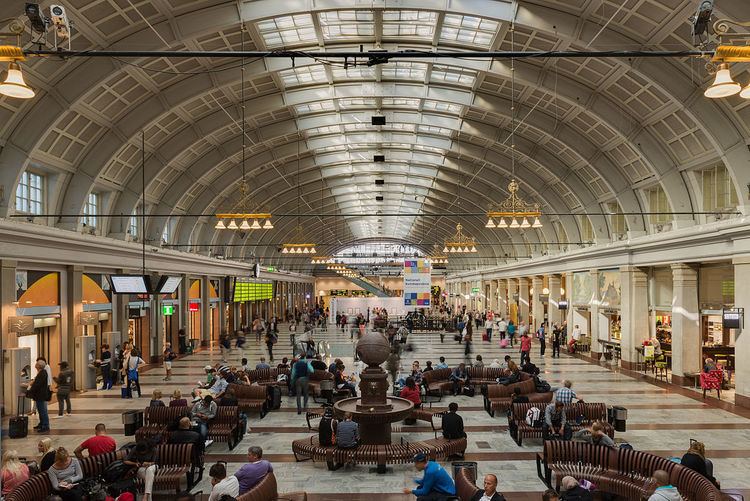Phone +46 77 192 19 21 Platforms in use 17 | Elevation 3 m Opened 18 July 1871 Owner Jernhusen Architect Adolf W. Edelsvärd | |
 | ||
Operated by Arlanda ExpressStockholmstågSJVeolia Transport Line(s) OstkustbananVästra stambanan Similar T‑Centralen, Cityterminalen, Gamla stan, Klara Church, Odenplan metro station | ||
Sweden stockholm central station walking from commuter trains to vasagatan exit
Stockholm Central Station (Swedish: Stockholms Centralstation, Stockholm C) is the largest railway station in Sweden. It is situated in the district of Norrmalm at Vasagatan/Central Plan. The station opened on 18 July 1871 and it has over 200,000 visitors daily, of which about 170,000 are travellers (105,000 with commuter trains, 25,000 with Arlanda Express and 40,000 with other trains).
Contents
- Sweden stockholm central station walking from commuter trains to vasagatan exit
- History
- Traffic
- Commuter train station
- Bus
- Metro station
- Services
- References
Because it is the busiest station in Sweden, engineers use the heat generated by the thousands of visitors every day to help heat a nearby office building.
In front of the central station stands a statue of Nils Ericson.
History
The station was built between 1867 and 1871 with Adolf W. Edelsvärd as the architect. Until 1925 the tracks led in to the station but during a renovation 1925-1927 the tracks were moved to the west and the former track hall was converted into a 119 meter long, 28 meter wide and 13 meter high waiting hall. During the renovation the station was extended to the south through the construction of the southern pavilion. This part of the station currently houses a conference facility. Next to the conference facility is the Royal waiting hall where the Royal Family waits when travelling by train.
In 1951 the facade towards Vasagatan was changed and given a more simplified look. In 1958 an underground passage to T-Centralen was opened.
Traffic
The station consists of two parts:
On level with the Northern Railway Square are service depots for long-distance and regional trains. Terminating trains arriving from the south at tracks 17 to 19 for disembarkation, continue to the service depots where they are cleaned and have their supplies refilled. Then they continue back via tracks 10 to 12. Long-distance trains from tracks 4 to 8 are services in the same way near the Northern Railway Square.
Commuter train station
The Stockholm Central station is the busiest station on the Stockholm commuter rail, with about 53,000 boarding the trains and about as many disembarking every weekday (as of 2005). The commuter rail uses two platforms, one for tracks 13 and 14 (southbound trains) and one for tracks 15 and 16 (northbound trains). Each platform has entries with entry gates from the lower level and a ticket sales office on the upper level with an entry from Klarabergsviadukten.
The commuter trains go on their own tracks along Ostkustbanan via Tomteboda, and after Karlberg Station they go underneath the other tracks to avoid conflict with long-distance and regional trains. After the centre, they join the Stockholm connection railway to the south, which has had two tracks since 1871. In 2006, a decision was finally made to construct Citybanan, a new track in a tunnel, and Stockholm City Station, a new station for commuter trains below T-Centralen. The construction was started in January 2009 and is scheduled to be finished in 2017.
Bus
A bus terminal called Cityterminalen is located adjacent to the main station, directly connected by a short pedestrian tunnel.
Local services offered by SL stop at various bus stops close to the main station's exits.
Metro station
Services on all lines of the Stockholm Metro network are provided on a separate station named T-Centralen. An underground pedestrian passage connects it to Stockholm Central Station.
